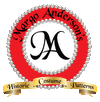We’ve talked about how to make ouches. Now I want to talk a little about design and about how to attach your finished ouches to your clothing.
Design is a subjective thing. I’m going to tell you what I think looks good, but if you feel differently, go with it!
I think what looks good is contrast. Varying shapes, colors, sizes, and textures makes for a dynamic design. Try putting rounds stones on square filigrees, or combining ovals and rounds. Accent a large central stone with tiny jewels. Combine gems and pearls for a combination of hard and smooth.
Designing
Try out your designs before glueing. If you don’t want to buy your stones before finalizing your design, pick up some inexpensive stones for experimentation. I bought a couple of bags of cheap plastic stones in various sizes for this purpose.
An advantage of working with filigree is that the symmetrical design acts as a grid that helps you place your stones accurately.
Play around with lots of combinations. I find that varying the shapes and sizes of your jewels makes the design more dynamic, as does using several colors at once.
If you can, keep your test pieces in place, or snap some photos, and take a few days to look at them and decide what you want.
Cleaning Your Ouches and Your Garment
When planning a project using ouches, you should consider how the garment will be cleaned. Plastic pearls can melt when dry cleaned, and either washing or dry cleaning could damage the finish on filigree. Glass jewels and rhinestones should never be put it the washing machine, as the agitation can scratch or even break them. Careful hand washing should’t be a problem, but I don’t guarantee it.
If you plan to wash or dry clean your ouches, I recommend making several samples, attaching them to a piece of your fashion fabric, and test washing or dry cleaning them.
To clean the ouches themselves, use baby wipes.
Wearing Ouches
It would probably be easier to say where and how Elizabethan people didn’t wear their ouches.
They were often placed on top of embroidery or other trims, on necklines, skirts, bodice or doublet openings, or on sleeves. Trims, embroidery, or pearls could also be applied in parallel rows, framing ouches placed between them, or the ouches could simply be placed next to each other to form the effect of a band.
Ouches could also be used as connectors to hold the edges of slashes or sleeve panes together.

Attaching Ouches
In the period, ouches were most likely sewn to the garment, and removed for cleaning or to switch to another garment. Labor was cheap, so employing someone to do this would not have been a problem for anyone who could afford to wear ouches.
Detachable Ouches
You may be tempted to make your ouches detachable for convenience in cleaning, buy using pin backs or other jewelry findings. I don’t recommend it. The pin back will make the ouch stand away from the garment, allowing it to catch on things. Either the pin will give way and the ouch will fall off and be lost, or the pin will hold and the fabric will tear.
Glue
You can glue your ouches to the garment, but the glue tends to show, and it makes it impossible to remove the ouches without damaging them or the fabric. However, If you're in a hurry, it can be a useful method. I once made a forepart with glued on plastic jewels and it lasted for years. If you are gluing to fabric, it works best if the fabric has a grippy texture, such as velveteen.
Sewing
The best way to deal with the issue is to do the authentic thing and sew your ouches to your garment.
To hand sew your ouches, use sturdy thread that matches the color of the filigree as closely as possible. Don’t use metallic thread, as it is not strong enough. Whipstitch through the holes on the filigree at several points around the edges. I like to seal the stitches with a drop of Fray-check or glue.

It is also possible to machine stitch your ouches, either using a button sewing foot or with the foot removed entirely, using your hands to keep the filigree in place. Set your stitch length to zero and the width wide enough to stitch over one bar of the filigree. Sew very carefully and slowly, and be sure to wear eye protection. After the ouch is stitched, use a hand sewing needle to take the threads to the back and tie them off.
Personally, I find that machine sewing ouches on is more trouble than it’s worth, and would prefer to hand sew them, but if you’re on a time crunch, it’s worth a try.
Ouches as Jewelry
Technically ouches are jewelry, but they can also be combined with chain, strung pearls or other beads, or attached together with jump or split rings to make necklaces, collars of office, girdles, and the like. I will talk about how to do this in a future post.

This is an amazing article!
Margo thank you so much about the articles on ouches. You have been an inspiration for me. I look forward to working with what I have. Again thank you so much.
Leave a comment